Have you ever wondered what the most savage animals on the planet are? Here are our top 10 picks. I think you'll be surprised by some of them!

Black Mamba – Dendroaspis polylepis
Black mambas are considered the world’s deadliest snake. They live in the savannas and rocky hills of southern and eastern Africa. They are highly aggressive if they feel threatened. They are fast, nervous, and extremely venomous.
Black mambas are not actually black in color. Their skin color can range from olive to gray. They get their name from the blue-black color inside their mouth, which they display when threatened.
Black mamba can grow up to 14 feet long but average about 8.2 feet long. They typically weigh about 3.5 pounds. They are the fastest snake in the world, moving up to 12.5 miles per hour.
Black mambas are typically shy and will almost always seek to escape when confronted. If cornered, they will raise their heads, sometimes with a third of their body off the ground, spread their cobra-like neck-flap, open their black mouths, and hiss.
If the black mamba does attack, it will strike not once, but repeatedly, injecting large amounts of venom with each strike. Black mamba venom is a lethal combination of neurotoxins and cardiotoxins. A single bite is toxic enough to kill 10 people. While a black mamba bite is now treatable with antivenin, it was once almost always fatal, usually within 20 minutes.
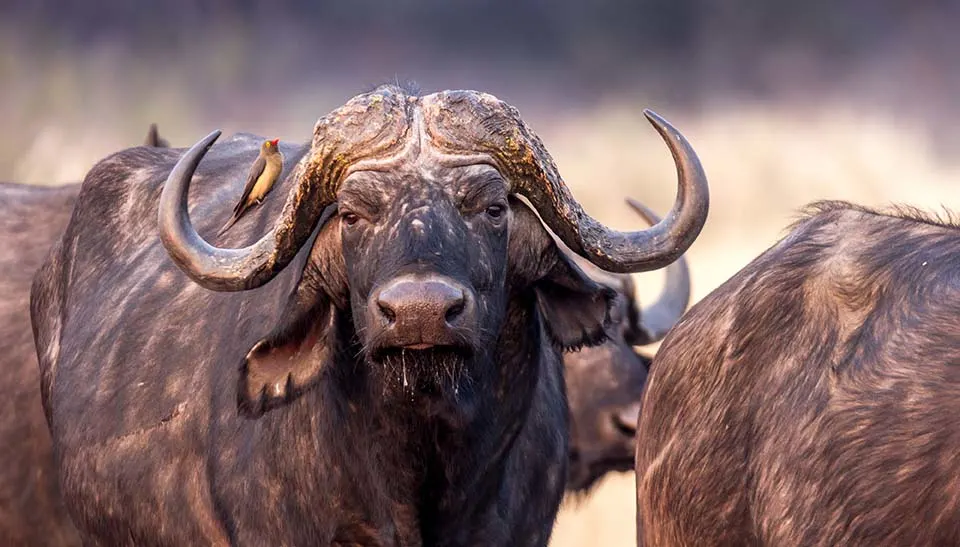
Cape Buffalo – Syncerus caffer
The Cape buffalo is native to sub-Saharan Africa. They prefer open and wooded savanna with grass cover near water sources. They can weigh up to 2,200 pounds (1,000 kilograms) and grow up to 5.6 feet (1.7 meters) tall. It is considered the most dangerous animal in Africa and has been called “widow maker” and “the black death.”
Cape buffalo primarily travel in herds, but the danger typically lies with older males who usually live away from the herd alone or in small groups. These males are easily provoked. However, Cape buffalo will mob any predator that threatens their young.
When a Cape buffalo prepares to attack it will hold a head-high pose, with its nose pointed downward and its shoulders hunched. If a bull wants to emphasize its size it may stand sideways to its opponent. If the initial threats don’t work, they may display more intense behaviors such as head-tossing, short chases, horn hooking, and soil gouging.
A favorite target of big game hunters, Cape buffalo are known to attack humans by circling back on their victims before charging, then trampling or goring them to death using their sharp horns.
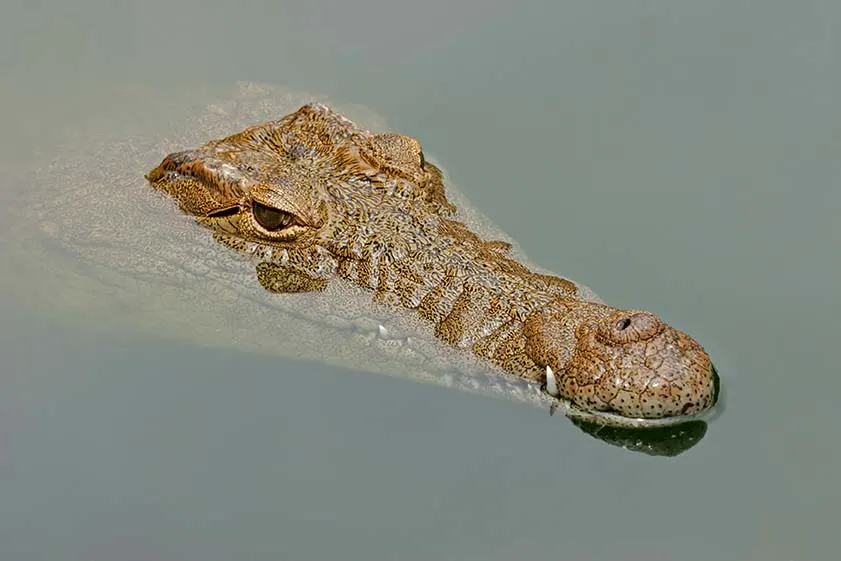
Nile Crocodile – Crocodylus niloticus
Nile crocodiles are found in almost every major river in Africa and in many lakes. They are Africa’s largest freshwater predator. They often have greenish-yellow scales with brown or bronze highlights. The coloring will vary depending on their environment. They are cold-blooded animals with efficient metabolisms.
They can go long periods of time without eating and can live between 70-100 years. Nile crocodiles can range from 11.5-16.4 feet from snout to tail for males and 7.3-12.6 feet for females. They can weigh between 500-1,650 pounds.
Nile crocodiles have between 64-68 teeth on both sides of their jaws. The teeth are cone-shaped but are finely sharpened. Baby crocodiles have a prominent “egg tooth” that falls off once it serves its purpose of breaking through the shell.
Nile crocodiles can move quickly over dry land. They have a “high walk” where they raise their bodies off the ground to gain speed, and smaller crocodiles can even achieve a “gallop” with speeds up to 20 mph.
Nile crocodiles have no natural predators. They are fearless ambush animals and able to take down everything from a jackrabbit to a full-sized hippopotamus. They will sink underwater and wait for prey to come to approach to drink or collect water. The crocodile will spring into action, clamping the victim with its powerful jaws.
The bite force of adult male Nile crocodiles is between 3,000 – 5,000 pounds per square inch (psi). For comparison, the human bite measures around 150 – 200 psi. However, crocodile bites aren’t automatically fatal. They drag their prey into the water to drown them or thrash them. They often stash their prey under submerged branches or rocks to eat at a later time.
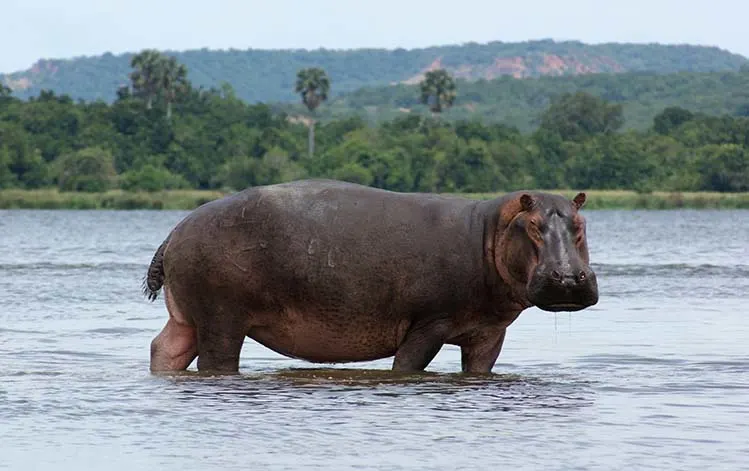
Hippopotamus – Hippopotamus amphibius
The Hippopotamus is considered one of the most dangerous animals in the world. Hippos are the third largest animal in Africa behind the elephant and rhino. Hippos can run on land at speeds of up to 18.6 miles per hour (30 kph). They grow to between 10.8 and 16.5 feet (3.3 to 5 meters) long and up to 5.2 feet (1.6 m) tall at the shoulder.
The average female weighs around 3,000 lbs. (1,400 kilograms), while males weigh 3,500 to 9,920 lbs. (1,600 to 4,500 kg). They have large teeth and tusks that they use for fighting off threats, including humans.
Hippos are aggressive and are considered very dangerous even by other aggressive animals that share their environment with hippos, such as crocodiles. They rarely get involved with them and most of the time choose to respect their space.
Male hippos fiercely defend their territories, to include the banks of rivers and lakes. Female hippos can get extremely aggressive if they sense anything getting between them and their young, who stay in the water while they feed on the shore.
Sometimes young hippos fall victim to adult hippos' tempers. During a fight between two adults, a young hippo caught in the middle can be seriously injured or even crushed.
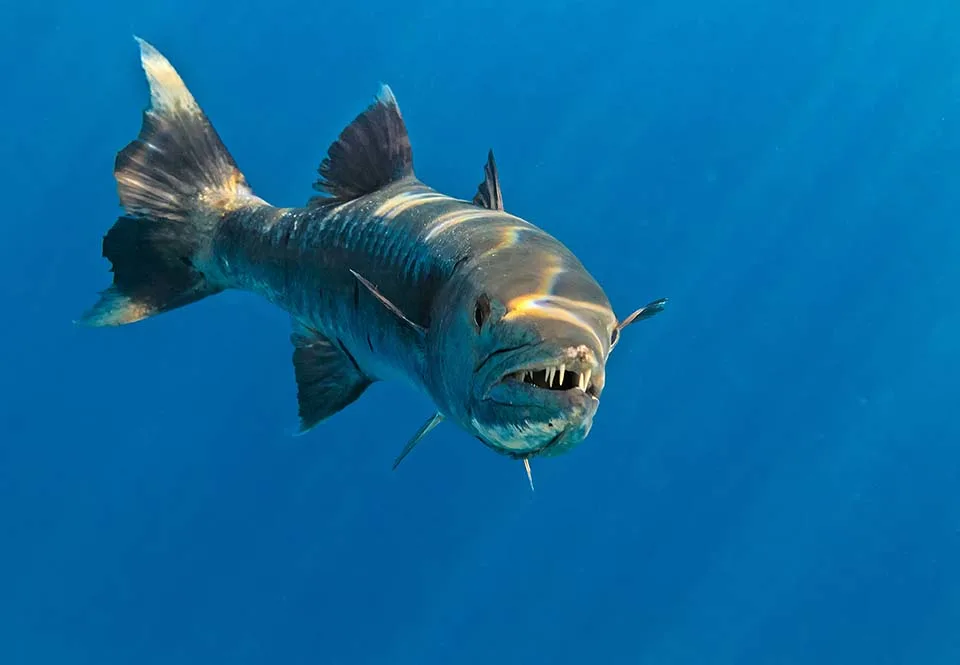
Barracuda – Sphyraenidae Sphyraena
Barracudas are found in tropical and subtropical oceans worldwide ranging from the eastern border of the Atlantic Ocean to the Red Sea, on its western border the Caribbean Sea, and in tropical areas of the Pacific Ocean.
They reside near the top of the water and near coral reefs and sea grasses. Barracudas are typically between 20 inches to 6.5 feet long. The typical lifespan can exceed 14 years. They can swim in bursts of 25 miles per hour.
Barracudas have bad eyesight but are attracted to shiny objects. They can mistake shining objects for light glinting off the scales of a fish. They have powerful jaws filled with fangs and even an exploratory bite can do damage.
In a contest between sharks and barracudas, even fairly aggressive sharks like the Great White, many fisherfolks give the barracuda an edge. Barracudas don’t have many natural predators except sharks and orca whales.
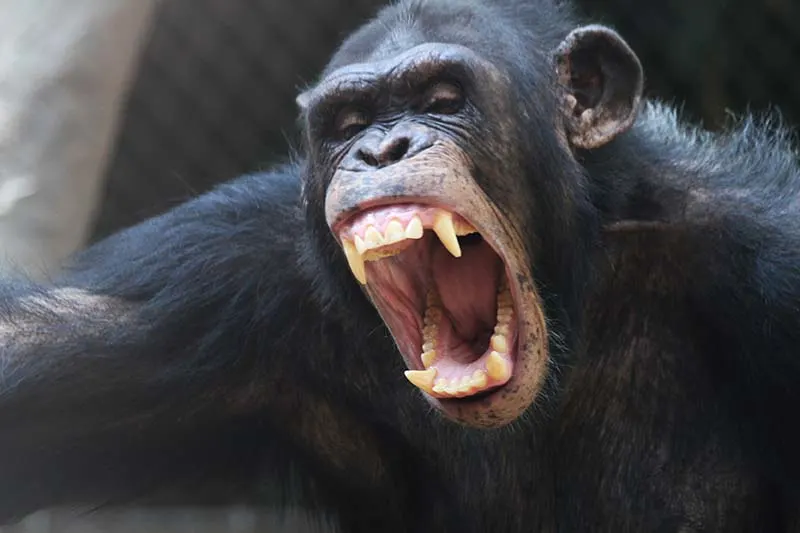
Chimpanzees – Pan troglodytes
Chimpanzees live in forests across the African continent. They live in complex societies and are known for being intelligent and social. Chimpanzees are omnivorous. Chimpanzees can behave with a nearly humanlike viciousness.
They may lack a theory of mind, which means they can’t understand or empathize with their victims. Chimpanzees’ favorite primate prey are colobus monkeys and have been known to kill and eat human babies, probably mistaking them for a colobus.
Wild chimpanzees are usually fearful of humans and keep their distance. However, when humans move into and destroy their habitat, they have been known to attack and kill people.
During attacks, chimps will target a person's face, hands, feet and genitals.
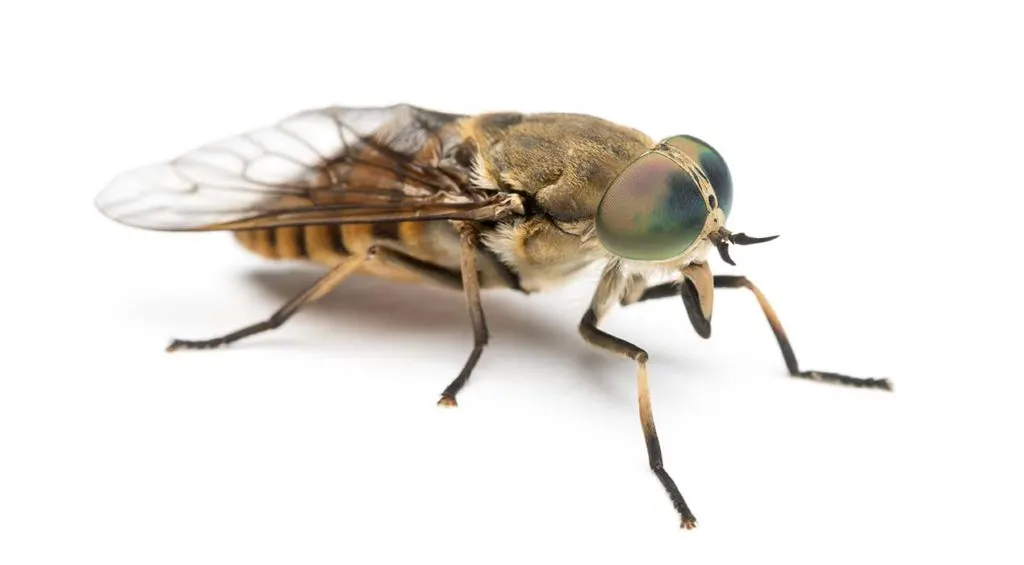
Horsefly – Tabanidae
Horseflies are mostly found in valley pastures near creeks and streams, preferring more warmth and dampness, and areas where livestock and humans can be found outdoors. They are large and aggressive.
Horseflies can be yellowish-brown to dark grey to blackish in color and typically measure about 3/4″ to 1.25″ in length. They are known for their large, colorful eyes. They are among the largest of all the fly species, and there are about 3,000 species of horsefly around the world.
The female horsefly needs a blood meal in order to successfully reproduce and will bite humans and other animals (notably horses and other livestock) in search of blood meals.
Its bite is memorably painful. This may be because the horsefly evolved to bite animals that couldn’t easily swat it away, so it didn’t bother to evolve an anesthetic in its saliva like the mosquito. The horsefly uses its Swiss Army knife-like mouthparts to open a wound and enlarge it. It then drinks the blood and adds anticoagulants to keep it from clotting.
If brushed away, it will either keep trying to come back or find another host. This is how they spread diseases, parasites, bacteria and blood contaminants from one host to another. They can make livestock and humans extremely sick, and even cause reduced growth rates and milk output in cattle.
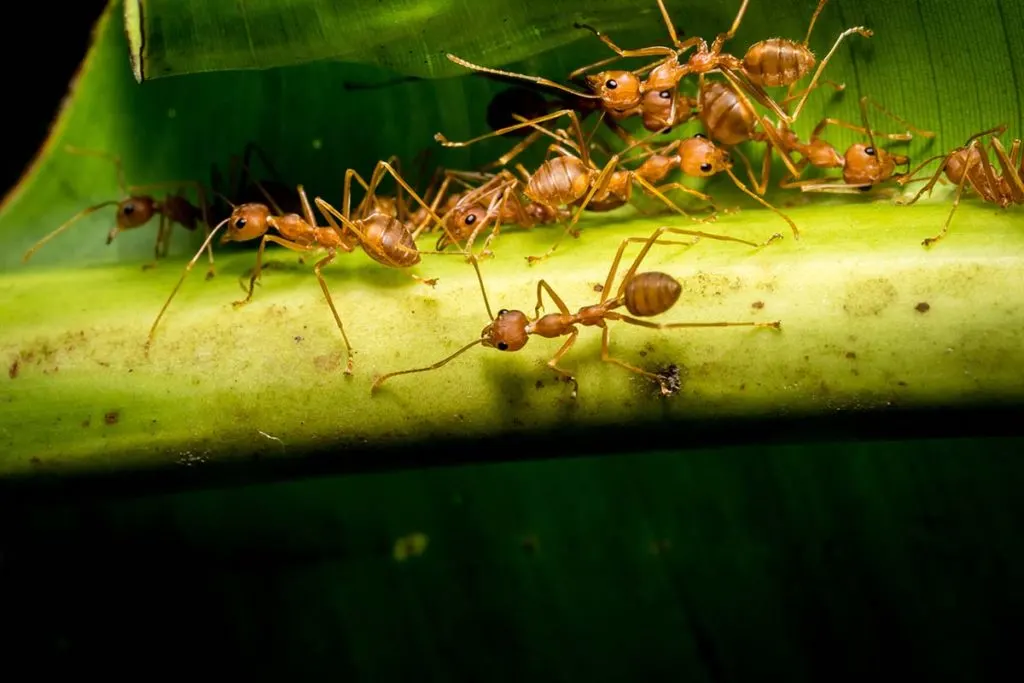
Fire Ant – Solenopsis invicta
Fire ants are medium-sized red and black colored ants that build mounds of soil. Worker fire ants vary in size from small (1/16 inch) to large (almost ¼ inch) in length. There are several Solenopsis fire ant species that are native to the U.S. but there are also red and black imported fire ants that are native to South America but were accidentally introduced into the U.S. in the 1930’s.
The fire ant is one of the few animals that attack for what seems like no reason. When disturbed, fire ants react aggressively, crawling up vertical surfaces, biting and stinging “all at once.” Fire ants are sensitive to vibration or movement and tend to sting when the object they are on moves. For example, when fire ants swarm up a person’s leg, the person jerks or moves.
The pain of the fire ant sting feels like being pierced by a red-hot needle and lasts for several hours. The sting is followed by a welt, then a blister that will dry out over time if undisturbed. People who are sensitive to the fire ant’s venom, which is made of poisons called solenopsins, can become ill if they are bitten by many fire ants. A severe reaction can result in anaphylactic shock.
Fire ants are not only aggressive toward people but toward other species of ant. It is unusual to find an area where fire ants and other types of ants live harmoniously.
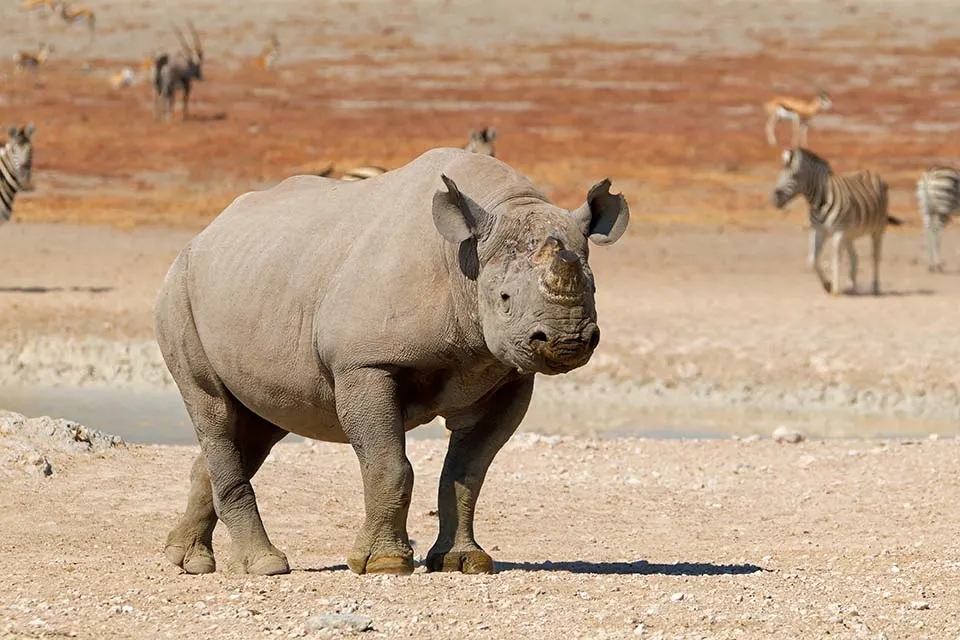
Black Rhinoceros – Diceros bicornis
The black rhinoceros is found in wooded areas in eastern and southern Africa. They are generally solitary and spend their time grazing.
They are herbivores that live on a vegetarian diet of leaves and fruit from trees and bushes. They have a reputation of being more aggressive and curious than the white rhino, which is normally a bit calmer.
While black rhinos appear docile, if provoked, their reactions can be unpredictable. They have a massive body, large horns, and surprising speed of 35 mph.
The main reason behind the aggressiveness of black rhinos is their poor eyesight. They easily become aggressive and attack anything they perceive as a threat. When a black rhino believes it’s being threatened, it turns its body holding its head high, trying to identify the danger and its position.
Because of its mediocre sight, if they feel threatened and trapped, they always react by attacking. They have even been observed charging tree trunks and termite mounds.
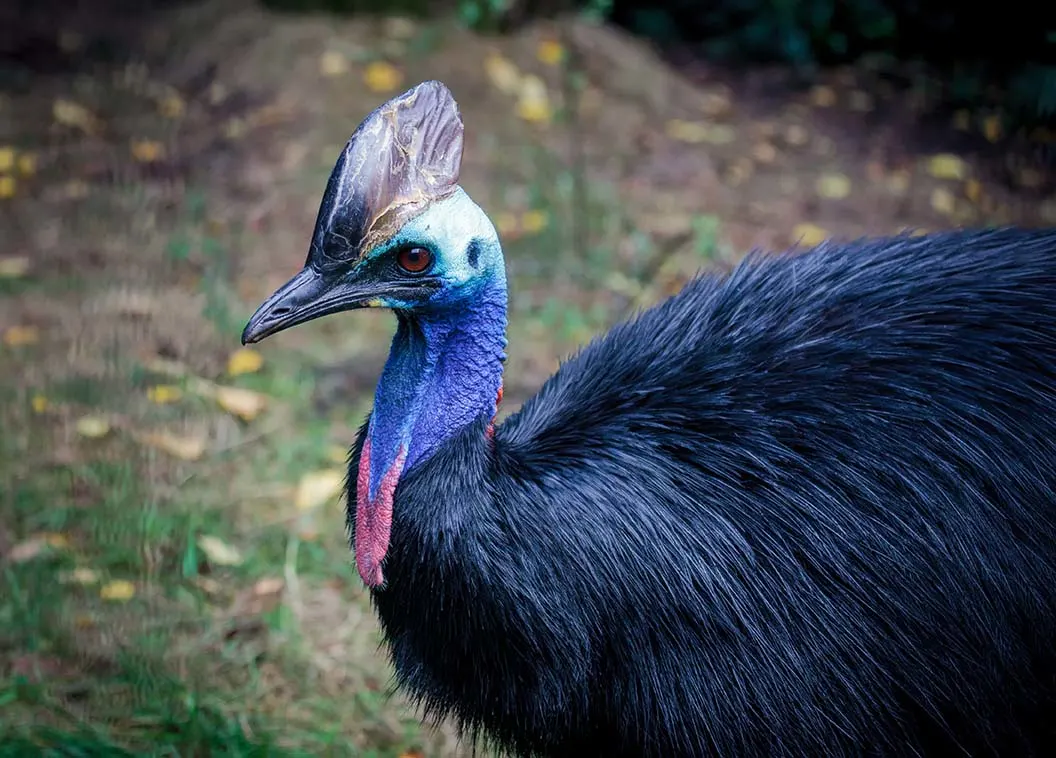
Cassowary – Casuarius casuarius
Found in Australia, the cassowary is the most dangerous bird in the world. They stand 5 to 6.5 feet (1.5 to 2 meters) tall and weigh 110 pounds to over 160 pounds.
Resembling a combination of a turkey and an ostrich, their body features different colors and textures (from feathers to skin) like that of a dinosaur. They have a large, black-feathered body, bluish skin on their head, reddish skin on their neck, and blue-grey colored legs.
The cassowary, like the emu and the ostrich, is a flightless bird. Although they cannot fly, they can put up a fight, jumping as high as 6.5 feet (2 meters) from the ground, and they can run at a speed of up to 31 miles per hour (50 kph).
Despite its reputation, the cassowary will not attack for no reason but if provoked, they become extremely aggressive and attack viciously. Powerful legs and sharp claws are primary weapons of cassowaries.
Cassowaries are quite territorial and defensive of their young. The main reason for attacking is most often self-defense related to their territory or young. They may also attack if they are expecting food from people who approach them. Cassowaries also dislike dogs and cats, sometimes attacking without provocation. They’ve also been known to attack horses and cows.
And there you have it! Our picks for the 10 most savage animals on the planet. What do you think? Leave us a comment with the animal that you don't want to meet up with.
